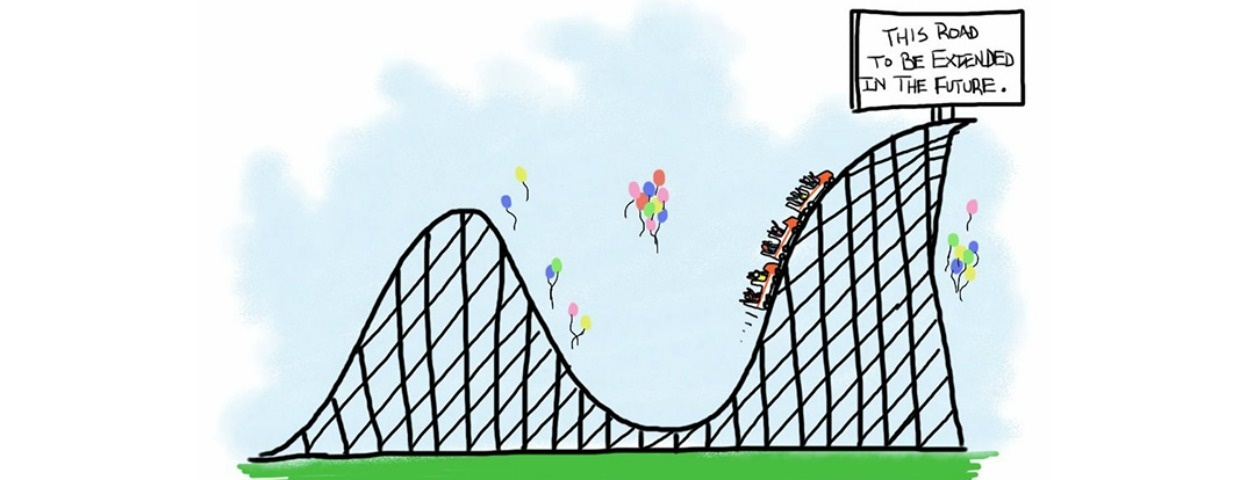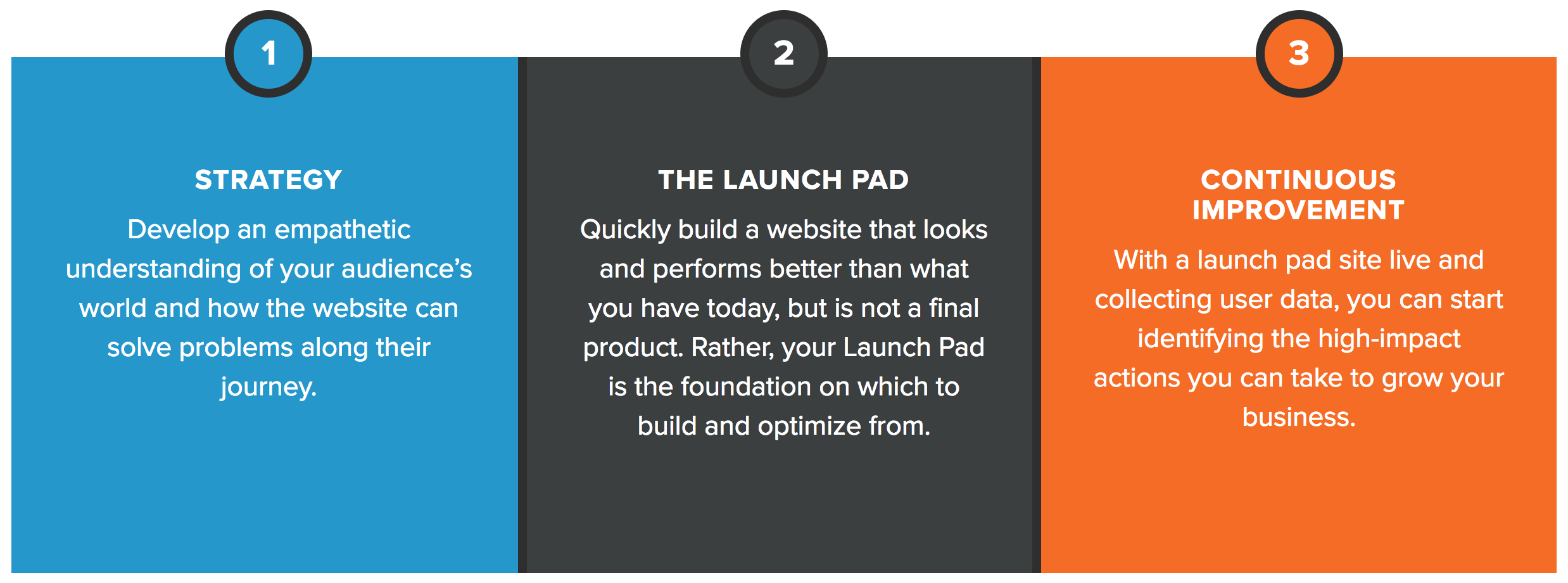Put Your Damn Website on the Internet
Posted by Lindsey Bowshier on May 26, 2021 1:26:00 PM

If you build a website and never put it on the internet, is it really a website?
This is not a deep philosophical question. It has a simple answer.
NO.
A development site is like an unsent email in your draft folder or all those baby pictures of your teenager on your phone that you keep meaning to back up to your computer or maybe even print and hang on the wall.
So then why are there so many websites living in the purgatory of a development environment instead of on the world wide web?
This is not a rhetorical question. It also has a simple, though not as brief, answer.
Websites Were Built Wrong for Two Decades
The reason so many website projects stall when they are near completion is because people have been conditioned over the last 20 years to believe that when a website goes live on the internet, the project is over. Done. Finished. Complete. They think every last detail has to be perfect before a single web crawler or internet-using human can know of its existence. They worry that any changes made after the launch of the website will be complicated or will cost as much or take as long as the entire site build or that their web development company will stop taking their calls and they will be stuck with that one word on that one page that just isn’t quite the best word to describe that one product with no ability to change it EVER. AAAGGGHHHH!!!!
And perhaps this used to be true. But no longer!
Websites today (for the most part), are no longer scary stretches of code that only a computer scientist can understand (well, at least not the part that you have to look at). Now, websites are built in content management systems like HubSpot, Drupal, WordPress, and so on, which allow even the least tech savvy user to make simple updates to text and images.
Another incredible advancement to the world of web development is the ability to gather data about how people are actually using your (live) website through the use of heat mapping and site recording software. See, when you are building a website, you and your web development team are going to start by making a lot of assumptions. Sure, you are at an advantage when you work with a professional web development company and at even more of an advantage when that web development company also has a deep understanding of marketing and a focus on user experience strategy, because then you at least know those assumptions are made by pulling from a deep well of experience and talent. But still, you can “best practice” your website from front to back, start to finish, but the only way to really know what will convert and what won’t is to let people use it.
And that is why, by taking the website live, you are only just BEGINNING!

Done is Better Than Perfect
Tribute Media didn't invent the phrase "done is better than perfect," but we sure like it. This concept is at the heart of an innovative approach to web development and marketing we like to call "Website Optimization"--other adopters of this philosophy will also refer to this approach as Growth-Driven Design, or simply WebOps.
First, let's establish what “done it better than perfect” DOES NOT mean:
- Sloppy is better than perfect
- Broken is better than perfect
- Incomplete is better than perfect
The idea here is to get away from the old way of doing things where website development projects used to take, on average, three months, though sometimes much longer. And then once a site was launched, it would sit stagnant for up to three YEARS (though, too often, much longer).
That. Is. Crazy.
Get it live, then make changes based on real data, rather than speculation.
If you won't listen to me, maybe you'll listen to this monkey:
The Value of the Minimum Viable Product
Your minimum viable product (MVP), or launch pad site as we call it here at Tribute Media, needs to be the minimum required to have a fully functional product, but no more. Keep it simple. You don’t have to install every feature you think could ever be helpful.
Once you get your launch pad site onto the web, you have the opportunity to get the answers to all those questions you’ve been pondering while looking at your website in the development environment:
- Will people notice that button?
- Should we make that whole image clickable?
- Will that call-to-action really inspire site visitors to convert?
- Is there too much content on this page?
- Are more people going to be looking at this on a phone or a desktop?
...and on and on and on.
So instead of letting those questions prevent you from launching at all, get your MVP out there on the web and start getting real data from real site users and make meaningful updates accordingly and regularly!
If this sounds like crazy newfangled nonsense, consider how an MVP worked out for a little business you may have heard of.
Disneyland’s MVP
In his book Do It Right: A CEO’s Guide to Web Strategy, Tribute Media’s founder Corey Smith talks about the early days of Disneyland. When the theme park first opened in 1955, it had plenty of the attractions that everyone knows and loves today—Tomorrowland, the Jungle Cruise, Sleeping Beauty's Castle, stuff like that.
It didn’t have everything ready, though. It’s a Small World, for instance, didn’t open until 1956. Instead of waiting to get all the attractions done, Walt Disney opened the park when it looked good and had enough constructed to give people their money’s worth. If Disney had waited until every single attraction was finished, Disneyland would never have opened.
To put it another way, Disneyland opened when it had a minimum viable product or MVP. When it comes to your company’s online presence, you should take a similar approach.
Far too often, businesses let their marketing efforts gather dust while they fuss over bells and whistles on their website. This is like keeping Disneyland closed for 64 years until Star Wars-Galaxy’s Edge (Coming 2019) was complete.
Instead of trying to make your site absolutely perfect, focus on getting your MVP done. Build the things you absolutely need first and start a wish list of all the extra stuff that can be tackled later.
Worst Case Scenarios
Just in case you are still nervous, I have taken the liberty of thinking of the worst things that could possibly happen (it's a gift I have) if you launch a website before every last detail is absolutely perfect, and compared it to what will happen if you don’t launch your website:
Scenario 1 - There is a typo in your content.
The worst thing that could happen if your site is live: Someone will see it and say, “tsk tsk tsk… I will not work with someone who can make such a mistake” and you don’t get the business.
What will probably happen if your site is live: Someone will call or email and say, “Dude, did you know there is a typo on your site?” and you will feel a little embarrassed but will fix it right then and there.
What will happen if your site is NOT live: No one will see your typo or any other words that are spelled correctly or any of the improvements you’ve made from your old, dated, non-responsive website.
Scenario 2- You didn’t pick the best image to represent your product or service
The worst thing that could happen if your site is live: Your site visitor won’t fall in love with your product instantly.
What will probably happen if your site is live: When you find a better image later, you’ll change it.
What will happen if your site is NOT live: No one will know that you even offer any products.
Scenario 3 - Your call to action isn’t compelling enough to convert visitors to leads
The worst thing that could happen if your site is live: Visitors won’t convert into leads.
What will probably happen if your site is live: You’ll notice that visitors are not converting into leads and you will try testing different language and images until you find what works best.
What will happen if your site is NOT live: Visitors CANNOT convert into leads because you don’t have a website they can visit. Or the site they are visiting doesn't have that call to action to convert them at all.
In conclusion, put your website on the damn internet. There will be kinks to work out and improvements to be made but at least you’ll be making updates in response to real data and real user activity, rather than best guesses and speculation.
Written by Lindsey Bowshier
Lindsey is the President of Tribute Media. Her degree is in English and Communication with an emphasis in Journalism, her background is in copywriting and content marketing, and she's had pretty much every job at Tribute Media since she joined the agency in 2014. Outside of work, Lindsey participates in a "super-cool-not-at-all-nerdy" writing group. Her favorite writer is Dorothy Parker.


